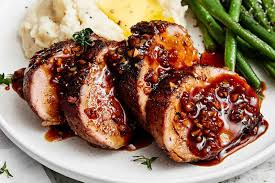Grilling Pork Tenderloin

Pork tenderloin is a versatile cut that can be enjoyed in a variety of ways. When grilled, pork tenderloin becomes juicy and flavorful thanks to the Maillard reaction.
For perfect results, use the two zone grilling method. This involves scooting hot coals to one side (if using a charcoal grill) or turning off half the burners if you’re using a gas grill.
Preparation
Pork tenderloin is a lean cut that can dry out quickly on the grill. To avoid this, it’s important to season the meat before it goes on the grill and to use a temperature probe or meat thermometer to monitor the internal temperature. Thermometers are an inexpensive investment and will save you from serving under-cooked pork.
The first step to preparing pork for the grill is trimming any excess fat and removing silver skin (the smooth, shiny connective tissue on the surface of the meat). It’s important to remove this before grilling because it won’t break down and can be tough if cooked. You can usually work it off with your fingers or a fillet knife.
Many recipes will call for applying a rub or marinade to the pork before grilling to add additional flavor. If you do, make sure to allow the meat to rest in the fridge for at least 30 minutes so that it absorbs the flavors of the marinade or rub.
For a quick and simple meal, grill pork tenderloin with Kosher salt and black pepper. This is an excellent option if you don’t have the time to brine the meat. Pork is a healthy choice for a weeknight dinner because it’s lower in saturated fat than many other meats and rich in essential nutrients.
Searing
Small enough to cook quickly for a weeknight meal, yet large and elegant enough to serve as a centerpiece roast, pork tenderloin is a versatile cut of meat. It is very easy to overcook if exposed to high heat, however, and it can also dry out or get bland without a good crust.
For this reason, searing the tenderloin before finishing it in the oven is a crucial step in getting the best results. Searing the meat first gives it a delicious, flavorful crust. It also protects the tenderloin from drying out when cooked at a lower temperature later in the oven.
Preheat a cast iron skillet or another pan that can move from stove to oven (cast iron is preferable). When hot, add a thin layer of butter or oil and heat until shimmering. Add the pork tenderloins to the pan and sear on each side until browned, 2 to 3 minutes per side. Rotate the tenderloins 1/3 of a circle each time you flip them.
Some recipes or rubs will recommend applying the seasoning blend to the meat and letting it marinate a couple of hours before grilling. The acidic ingredients in the marinade help tenderize the meat and add a hint of flavor.
Two-Zone Grilling
One of the most effective ways to grill any cut of meat is using two-zone cooking. This technique takes the guesswork out of how long to cook your meats because it separates the grill into zones of different temperatures. It’s easy enough to do and allows you to better control the grilling process. Using two-zone grilling will make burnt burgers and tough steaks things of the past.
Preheat the grill to high heat. When the grill reaches the right temperature place the pork tenderloins on and sear them for about a minute on all four sides, keeping the lid closed between turns. Then move the pork tenderloins to the indirect heat zone and continue grilling until a meat thermometer inserted in the thickest part of the tenderloin reads 145 degrees Fahrenheit.
The indirect heat will cook the pork tenderloins without overcooking them, and it will also allow the pork tenderloins to marinade in their own juices as they rest. Once the pork is done, remove it from the grill and allow it to rest for 10 minutes before slicing. While the meat rests it will finish cooking to its optimal temperature and the juices will redistribute for maximum flavor.
Pork tenderloin is a very lean cut of meat and requires a high grilling temperature to ensure that it cooks through before it dries out. This method of grilling is an excellent way to guarantee that your pork tenderloin will be moist and tender every time you use it.
Resting
Pork tenderloin is a lean cut of meat, so it can quickly go from fork-tender to dry and chewy if overcooked. Using the sear-and-roast technique helps ensure that your pork reaches a safe internal temperature, while allowing for a juicy, flavorful crust that also develops a nice caramelization.
This cooking method is easy to execute, and it produces consistently excellent results. Our test strips of pork were juicy and incredibly tender with an intense, robust grilled flavor. They were also nicely browned and had an appealing, burnished crust that was perfectly crunchy. This method works best for grilling over indirect heat, which gives the pork a chance to cook evenly and without burning or scorching.
A meat thermometer is a crucial tool for ensuring that your pork is cooked to the right level of doneness. Insert the probe into the thickest portion of your pork tenderloin and monitor its temperature until it reaches 140 degrees F for medium rare, 145 degrees F for medium, or 150 degrees F for well done.
Once the pork has reached a safe temperature, remove it from the grill and let it rest for 10 minutes before you slice it. The resting time allows the juices to redistribute throughout the pork, making it juicier and more flavorful. Serve the sliced pork on a sandwich or salad, or cut it into cubes to add to soup.